If in the quadratic equation ax2 + bx + c = 0 the second factor b is even, then the solution of this equation can be simplified a little. The discriminant for such an equation can be calculated by the formula D1 = k2 − ac, and the roots by the formulas  and
and  .
.
Examples
Solve the quadratic equation x2 + 6x − 16 = 0. In this equation, the second coefficient is even. To use the formulas for the even coefficient, we first need to know what the variable k is equal to.
Any even number n can be represented as the product of number 2 and number k, that is, 2k.
n = 2k
For example, the number 10 can be represented as 2 × 5.
10 = 2 × 5
In this product k = 5.
The number 12 can be represented as 2 × 6.
12 = 2 × 6
In this product k = 6.
The number -14 can be represented as 2 × (-7)
In this product k = -7.
As we see, the factor 2 does not change. Only the factor k changes.
In the equation x2 + 6x − 16 = 0, the second coefficient is 6. This number can be represented as 2 × 3. In this product k = 3. Now we can use the formulas for the even coefficient.
Find the discriminant by the formula D1 = k2 − ac
D1 = k2 − ac = 32 − 1 × (−16) = 9 + 16 = 25
Now let's calculate the roots using the formulas:  and
and  .
.

So the roots of the equation x2 + 6x - 16 = 0 are the numbers 2 and -8.
Unlike the standard formula for calculating the discriminant (D=b2 - 4ac), the formula D1 = k2 - ac does not need to multiply the number 4 by ac.
And unlike formulas  and
and  , formulas
, formulas  and
and  do not contain the factor 2 in the denominator, which again frees us from additional calculations.
do not contain the factor 2 in the denominator, which again frees us from additional calculations.
Example 2. Solve the quadratic equation 5x2 − 6x + 1=0
The second coefficient is an even number. It can be represented as 2 × (-3). That is, k = -3. Find the discriminant by the formula D1 = k2 − ac
D1 = k2 − ac = (−3)2 − 5 × 1 = 9 − 5 = 4
The discriminant is greater than zero. So the equation has two roots. To calculate them we use formulas  and
and 

Example 3. Solve the quadratic equation x2 − 10x − 24 = 0
The second coefficient is an even number. It can be represented as 2 × (-5). That is, k = -5. Find the discriminant by the formula D1 = k2 − ac
D1 = k2 − ac = (−5)2 − 1 × (−24) = 25 + 24 = 49
The discriminant is greater than zero. So the equation has two roots. To calculate them we use formulas  and
and 

The usual way to determine the number k is to divide the second coefficient by 2.
Indeed, if the second quotient b is an even number, it can be represented as b = 2k. In order to express the factor k from this equality, one must divide the product of b by the factor 2
![]()
For example, in the previous example you could simply divide the second factor -10 by 2 to determine the number k

Example 4. Solve a quadratic equation ![]()
The coefficient of b is ![]() . This expression consists of the multiplier 2 and the expression
. This expression consists of the multiplier 2 and the expression ![]() . That is, it is already represented as 2k. It turns out that
. That is, it is already represented as 2k. It turns out that ![]()
Find the discriminant by the formula D1 = k2 − ac
![]()
The discriminant is greater than zero. So the equation has two roots. To calculate them we use formulas  and
and 

Calculating the root of the equation produces a fraction that contains the square root of 2. The square root of 2 can only be extracted approximately. If you do this approximate extraction and then add the result to 2, and then divide the numerator by the denominator, you get a not very nice answer.
In such cases, the answer is written down without performing approximate calculations. In our case, the first root of the equation is  .
.
Calculate the second root of the equation:

How to derive formulas
Let's visualize how formulas for calculating the roots of a quadratic equation with an even second coefficient appeared.
Consider the quadratic equation ax2 + bx + c = 0. Assume that the coefficient of b is an even number. Then it can be denoted as 2k
b = 2k
Replace in the equation ax2 + bx + c = 0 the quotient of b by the expression 2k
ax2 + 2kx + c = 0
Now let's calculate the discriminant using the previously known formula:
D = b2 − 4ac = (2k)2 − 4ac = 4k2 − 4ac
In the resulting expression, take the common factor 4 out of the brackets.
D = b2 − 4ac = (2k)2 − 4ac = 4k2 − 4ac = 4(k2 − ac)
What can be said about the resulting discriminant? If the second coefficient is even, it consists of factor 4 and the expression k2 − ac.
In the expression 4(k2 − ac) the factor 4 is constant. So the sign of the discriminant depends on the expression k2 − ac. If this expression is less than zero, then D will be less than zero. If the expression is greater than zero, then D is greater than zero. If the expression is equal to zero, then D will be equal to zero.
That is, the expression k2 − ac is the discriminant. Such a discriminant is usually denoted by the letter D1
D1 = k2 − ac
Now let's see how formulas  and
and  are derived
are derived
In our equation ax2 + bx + c = 0 the quotient of b is replaced by the expression 2k. Use the standard formulas for calculating the roots. That is, we use formulas  and
and  . Only instead of b we substitute 2k. Also note that D equals the expression 4(k2 − ac).
. Only instead of b we substitute 2k. Also note that D equals the expression 4(k2 − ac).

But it was said earlier that the expression k2 − ac is denoted by D1. Then in our transformations we should make this substitution as well:

Now let's calculate the square root located in the numerator. This is the square root of the product - it is equal to the product of the roots. Let's rewrite the rest without changing:

Now, in the resulting expression, take the common factor 2 out of the brackets.

Let's reduce the resulting fraction by 2

Similarly, the formula for calculating the second root is derived:

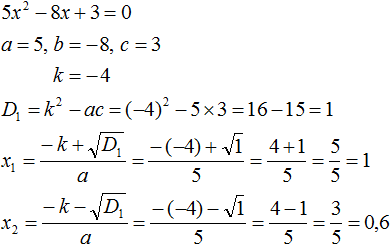
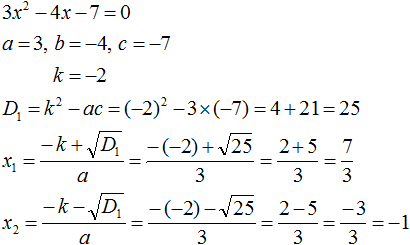
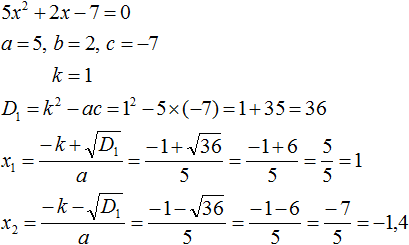
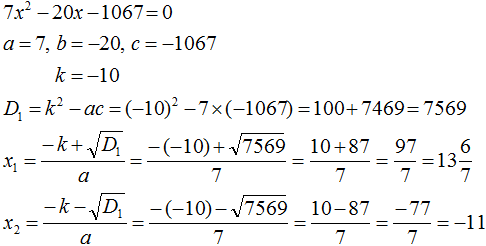
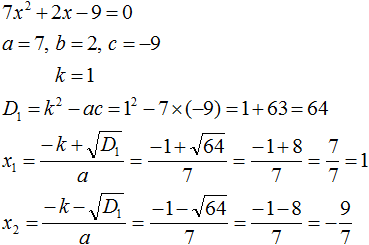
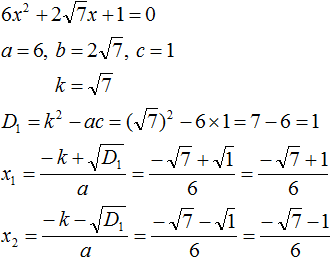

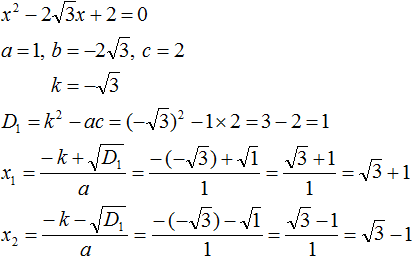
Comments